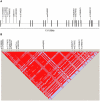Polymorphisms in the receptor tyrosine kinase MERTK gene are associated with multiple sclerosis susceptibility
- PMID: 21347448
- PMCID: PMC3035668
- DOI: 10.1371/journal.pone.0016964
Polymorphisms in the receptor tyrosine kinase MERTK gene are associated with multiple sclerosis susceptibility
Abstract
Multiple sclerosis (MS) is a debilitating, chronic demyelinating disease of the central nervous system affecting over 2 million people worldwide. The TAM family of receptor tyrosine kinases (TYRO3, AXL and MERTK) have been implicated as important players during demyelination in both animal models of MS and in the human disease. We therefore conducted an association study to identify single nucleotide polymorphisms (SNPs) within genes encoding the TAM receptors and their ligands associated with MS. Analysis of genotype data from a genome-wide association study which consisted of 1618 MS cases and 3413 healthy controls conducted by the Australia and New Zealand Multiple Sclerosis Genetics Consortium (ANZgene) revealed several SNPs within the MERTK gene (Chromosome 2q14.1, Accession Number NG_011607.1) that showed suggestive association with MS. We therefore interrogated 28 SNPs in MERTK in an independent replication cohort of 1140 MS cases and 1140 healthy controls. We found 12 SNPs that replicated, with 7 SNPs showing p-values of less than 10(-5) when the discovery and replication cohorts were combined. All 12 replicated SNPs were in strong linkage disequilibrium with each other. In combination, these data suggest the MERTK gene is a novel risk gene for MS susceptibility.
Conflict of interest statement
Figures

Similar articles
-
Common and Low Frequency Variants in MERTK Are Independently Associated with Multiple Sclerosis Susceptibility with Discordant Association Dependent upon HLA-DRB1*15:01 Status.PLoS Genet. 2016 Mar 18;12(3):e1005853. doi: 10.1371/journal.pgen.1005853. eCollection 2016 Mar. PLoS Genet. 2016. PMID: 26990204 Free PMC article.
-
The Gas6/TAM System and Multiple Sclerosis.Int J Mol Sci. 2016 Oct 28;17(11):1807. doi: 10.3390/ijms17111807. Int J Mol Sci. 2016. PMID: 27801848 Free PMC article. Review.
-
Antagonistic Coevolution of MER Tyrosine Kinase Expression and Function.Mol Biol Evol. 2017 Jul 1;34(7):1613-1628. doi: 10.1093/molbev/msx102. Mol Biol Evol. 2017. PMID: 28369510 Free PMC article.
-
Association study between polymorphims in GAS6-TAM genes and carotid atherosclerosis.Thromb Haemost. 2010 Sep;104(3):592-8. doi: 10.1160/TH09-11-0787. Epub 2010 Jul 20. Thromb Haemost. 2010. PMID: 20664904
-
The role of non-HLA single nucleotide polymorphisms in multiple sclerosis susceptibility.J Neuroimmunol. 2010 Dec 15;229(1-2):5-15. doi: 10.1016/j.jneuroim.2010.08.002. Epub 2010 Sep 15. J Neuroimmunol. 2010. PMID: 20832869 Review.
Cited by
-
Involvement of receptor tyrosine kinase Tyro3 in amyloidogenic APP processing and β-amyloid deposition in Alzheimer's disease models.PLoS One. 2012;7(6):e39035. doi: 10.1371/journal.pone.0039035. Epub 2012 Jun 11. PLoS One. 2012. PMID: 22701746 Free PMC article.
-
Phagocytosis in the Brain: Homeostasis and Disease.Front Immunol. 2019 Apr 16;10:790. doi: 10.3389/fimmu.2019.00790. eCollection 2019. Front Immunol. 2019. PMID: 31040847 Free PMC article. Review.
-
Phagocyte dysfunction, tissue aging and degeneration.Ageing Res Rev. 2013 Sep;12(4):1005-12. doi: 10.1016/j.arr.2013.05.006. Epub 2013 Jun 4. Ageing Res Rev. 2013. PMID: 23748186 Free PMC article. Review.
-
TAM receptor signaling in immune homeostasis.Annu Rev Immunol. 2015;33:355-91. doi: 10.1146/annurev-immunol-032414-112103. Epub 2015 Jan 14. Annu Rev Immunol. 2015. PMID: 25594431 Free PMC article. Review.
-
TAM receptor tyrosine kinases: expression, disease and oncogenesis in the central nervous system.Brain Res. 2014 Jan 13;1542:206-20. doi: 10.1016/j.brainres.2013.10.049. Epub 2013 Nov 1. Brain Res. 2014. PMID: 24184575 Free PMC article. Review.
References
-
- Compston A, Coles A. Multiple sclerosis. Lancet. 2008;372:1502–1517. - PubMed
-
- Hafler DA, Compston A, Sawcer S, Lander ES, Daly MJ, et al. Risk alleles for multiple sclerosis identified by a genomewide study. N Engl J Med. 2007;357:851–862. - PubMed
-
- Masterman T, Ligers A, Olsson T, Andersson M, Olerup O, et al. HLA-DR15 is associated with lower age at onset in multiple sclerosis. Ann Neurol. 2000;48:211–219. - PubMed
-
- Rubio JP, Stankovich J, Field J, Tubridy N, Marriott M, et al. Replication of KIAA0350, IL2RA, RPL5 and CD58 as multiple sclerosis susceptibility genes in Australians. Genes Immun. 2008;9:624–630. - PubMed
Publication types
MeSH terms
Substances
LinkOut - more resources
Full Text Sources
Other Literature Sources
Medical
Research Materials
Miscellaneous

